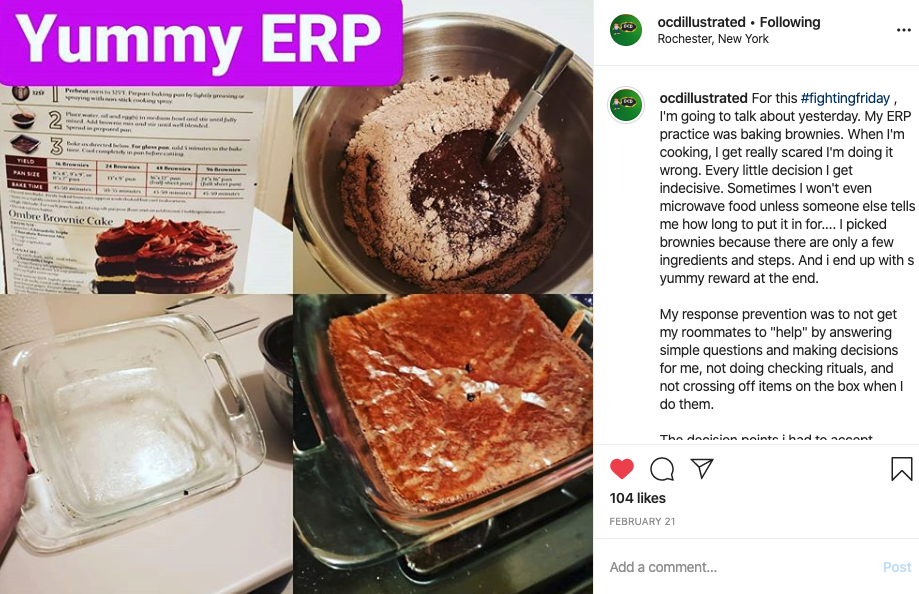A Conversation with Katie Strang: Tips for Finding Your Niche
/Me (left) with Katie Strang, creator of OCD Illustrated (right)
This is the third post in the “A Conversation With” series, where I interview talented folks about their areas of expertise, whether that’s social media, marketing, communications, or public relations. You can read past entries in the series here.
This month, I interviewed Katie Strang, a graduate student who has found her niche on Instagram. She runs @OCDIllustrated, an account dedicated to sharing what it’s like to live with OCD. In just a few short years, Katie has built a vibrant community. I hope you enjoy her tips and best practices!
Tell me about the concept for OCD Illustrated.
The goal of the account is to show what actual therapy for OCD looks like. I provide resources and metaphors to understand it better. I’m in a unique position to do this because I’m a clinician, graduate student, and person with OCD. I go back and forth between my personal perspective and offering resources and information in a more clinical way.
What inspired you to start OCD Illustrated?
I launched it in 2018 after experimenting with creating time-consuming YouTube videos. A roommate encouraged me to switch to Instagram; my biggest qualm was not wanting to put my face on it. I realized I could use Instagram to share photos of my life with OCD, therapy, and exposures as a way of illustrating what it’s like to have OCD.
Tell me about how your personal experience and graduate work both come into play running OCD Illustrated.
I’ve had OCD symptoms since elementary school; I officially got diagnosed at 16. It was really bad when I was in high school and I got treatment. In undergrad, I started taking psychology courses because I wanted to be a therapist for OCD. I had seen firsthand how life-changing evidence-based treatment is and how few people have access to it. After doing an internship at a summer residential program for kids with trauma and behavior disorders, I fell in love with working with that population. When I went back to grad school at Case Western, my field placement was with younger kids. It’s been surprising how little OCD has been covered in the grad school curriculum even though it’s the fourth most common diagnosis.
How did you find your niche on Instagram?
Under #OCD, most of the content was either jokes about OCD, posts about cleaning or design, and people who had OCD sharing inspirational quotes or asserting that OCD isn’t an adjective and true OCD is bad. There are a lot of therapists out there posting quotes and advice. But no one was sharing what day-to-day life with OCD is like, what treatment is like. That gap bothered me. I wasn’t willing to do the treatment until I saw it working for other people. Once I saw other teens facing their fears and being successful, it made me willing to try it. Now I feel that it’s really important to show exposure and response prevention therapy (ERP) working in order to encourage others to pursue it too.
An example of a post about ERP
How do you make yourself stand out among all the mental health content on Instagram?
I don’t have the most aesthetically pleasing feed and there’s no theme to my photos. What draws people to my content is two things: 1) really good writing and 2) a fresh perspective on living with OCD. Recently, I’ve been making an effort to do more interactive components, sharing open-ended questions where people can share their experience. It tends to draw a lot of people. I also aim to make OCD research accessible and get people excited about it, which is really cool.
Tell me about your Trivia Tuesday and Sunday Science Spotlight features. What sparked the decision to launch them?
Trivia Tuesday started last May for Mental Health Awareness Month. I decided to run that feature once a week, varying the difficulty of the questions and encouraging people to participate. I aim to have 200 people see it and at least half of those respond to a multiple choice question. Then I ask a related open-ended question and share people’s answers. That usually gets anywhere from 3-40 responses.
For Sunday Science Spotlights, I summarize a research article and connect it to living with OCD. They’re not my most viewed posts, but they’re some of the most commented on ones. I invite people to share their thoughts and it usually sparks a good discussion.
How do you use feedback from your community to shape the content you create?
On Saturdays, I post a poll in my Stories to give people a choice of what topic they want for my Sunday Science Spotlight. I also respond to every direct message I get, which I really enjoy. I try to create more content about whatever topics I’m getting lots of messages about.
I also spend time going through hashtags like #OCD and like and comment on other people’s posts. It starts creating relationships that get people to look at my content. I get followers from doing that. It’s not efficient, but I like talking to people.
An example of a recent Sunday Science Spotlight post
You have impressive engagement on your posts! How do you spark conversations?
I try to ask a question at the end of each post. I also include a question sticker in my story. If I ask a question that’s too meaty for Stories, people will hit the character limit then respond five times to give their full answer. Then I have to piece it all together to share their response, which doesn’t work very well. So for more substantial conversations, I ask people to leave their thoughts in a comment.
I also aim to create content that makes people think. I keep an eye on what people are talking about and put my own spin on it. I try to engage on a personal level.
What steps have you taken to ensure your community is a safe place for people to express themselves?
I’ve been lucky that I’ve only had a few bad experiences; only twice have people left comments that required me to block them. I think that me talking respectfully about other people, my own experience, and my own symptoms sets the tone. I’ve learned from my clinical experience to be the thermostat, not the thermometer. If you’re the leader, you don’t want to take on all the emotions and amp it up. You want to set the standards. That’s how I think about modeling respect and communication on my feed; if I’m doing it well, people are likely to follow.
If I am posting something to make people think about whether or not their behavior is helpful or harmful, I’m not doing it in a way that calls out an individual. It’s calling out a pattern I’m noticing and asking people to discuss the impact.
I also will comment on posts that are misusing the term OCD. If someone uses OCD as an adjective, I’ll respond as if they did truly have OCD, asking “Have you tried medication? What about therapy? I hate how OCD takes up so much time and stops us from doing the things we want to do!” If they don’t actually have OCD, they tend to backtrack quickly.
How do you show people you’re authentic without showing your face on Instagram?
It comes through what I write. I show real parts of my life. My photos aren’t very aesthetically pleasing, so that helps. I’m not creating some perfect picture. This is my real life, what I’m actually thinking and doing in the moment. You get way more information about someone’s emotional state from looking at their journal rather than their photo album. That’s my way of connecting- to show the journal and not the photo album.
What’s it like to be a micro-influencer in the mental health space?
It’s very exciting! Even over the two yours I’ve been doing this, things have challenged a lot. There’s a community that’s changing the way people talk about mental illness, and making it okay to talk about. Online communities are going to be a bigger and bigger thing. It gives people a way of connecting that can be really powerful.
What opportunities have you gotten as a result of running this account?
I got a part-time job with a mental health app, working with them as an advocate. I never thought I’d get a job from running this Instagram account! I had spoken at the International OCD Foundation conference in the past, but now I have new proposals submitted to speak with friends I met through the Instagram account. It’s also empowered me to educate my peers at grad school, giving presentations and inviting them to follow me to learn more about OCD. Practicing being open on Instagram has empowered me to be more open in real life too.
How do you avoid getting caught up in the cycle of attempting to get more followers and likes for validation?
I try hard to make sure the joy I get from Instagram isn’t tied to numbers. For me, it’s not about follower count or likes. I’d rather create content that is real to me and that I’m really proud of. That’s what matters.
Looking for more social media insights and resources? Sign up for my unboring email newsletter!








